by Lisa Cooke | Aug 19, 2016 | 01 What's New, British, Records & databases |
England emigrants to its U.S. colonies appear in new genealogy records online this week. Also: the 1891 New South Wales census; Czech church, land and school records; English parish records; and U.S. collections from the Freedmen’s Bureau, Marine Corps, Coast Guard and New England towns and cities.

Australia – New South Wales census
Findmypast.com has published over 200,000 records from the 1891 New South Wales census. The census collectors’ books are the source, as these are the only surviving documents. “While they provide less detail than a full census would, they can still be a useful aid to historians and genealogists alike in placing people at a specific moment in time,” states the collection description. “Each result will provide you with a transcript and image of the original collector’s books from the 1891 census. Original images may provide you with additional details, such as the number of individuals living in the same household or the number of residents who were Aboriginal or Chinese.”
Czechoslovakia – Church, Land and School
FamilySearch.org has added to its collection of Czech Republic Church Records spanning more than 400 years (1552-1963). You’ll find “images and some indexes of baptisms/births, marriages, and deaths that occurred in the Roman Catholic, Evangelical Lutheran, and Reformed Church parishes, as well as entries in those registers for Jews.” These are taken from parish registers and synagogue records now in regional archives. Though not fully indexed, the browse-only records number over 4 million! (Click here to learn how to use browse-only collections on FamilySearch.org; remember you can use the FamilySearch wiki for help in translating records in another language.)
FamilySearch has also added more than 850,000 browsable images to its existing collection of Czech Republic Land Records 1450-1889 and more than a million browsable images to the existing collection Czech Republic School Registers 1799-1953.
England Emigrants
Remember recently when we blogged about emigrant records, or those created about people leaving a country? Ancestry.com recently posted a new database called Emigrants in Bondage, which it says is “the most important list of ships’ passengers to be published in years.” Indexed are names of “more than 50,000 English men, women, and children… sentenced to be deported to the American colonies for crimes ranging from the theft of a handkerchief to bigamy or highway robbery.” The collection dates cover 1614 to 1775, after which time the British empire was not permitted to ship its “undesirables” to U.S. shores.
England – Parish records – Staffordshire and Sussex
Findmypast has added to its collections of church vital records for Staffordshire, England. Its browsable parish registers, 1538-1900 now includes 300,000 full-color page-by-page images. Separate databases of baptisms, wedding banns, marriages and burials have also been updated.
Also, more than 1.2 million indexed records have been added to FamilySearch’s collection of England, Sussex, Parish Records, dating 1538-1910. Sussex parish registers contain baptisms, marriages/banns, and burials. Date ranges of available records vary by locality; you will want to use the coverage table at the FamilySearch wiki to see what’s available.
U.S. – Freedmen’s Bureau Records
Now that the Freedmen’s Bureau collections have been fully indexed, FamilySearch is dumping them onto its website in batches. This week, they added these new databases:
U.S. – Military
FamilySearch.org has added just over 4 million indexed records to its database of United States Muster Rolls of the Marine Corps (1798-1937). The collection is described as an “index and images of muster rolls of the United States Marine Corps located at the National Archives. The records are arranged chronologically by month, then by post, station or ship.”
This week, the Fold3.com blog reminds us of its Coast Guard collections, in honor of the Coast Guard’s 226th birthday. Hundreds of thousands of search results on the site relate to Coast Guard history, from disapproved Navy survivors pension files to photos dating to the Civil War; accounts of shipwrecks or accidents, WWII war diaries for several units, images of insignia and Navy cruise books.
U.S. – New England
FamilySearch has posted a new index of New Hampshire Vital and Town Records Index for the years 1656-1938. It contains shy of half a million records of births, marriages and deaths. Entries were sourced from multiple archives in New Hampshire; the citation for each record is included in the index entry at the bottom of the record screen.
The New England Historic Genealogical Society has announced improvements to its databases for three New England cities, which now include more searchable fields and images. “Hartford, CT: General Index of Land Records of the Town of Hartford, 1639-1839, is now searchable by grantee and grantor name, and results provide the record type and volume and page of the record (available on microfilm at the Connecticut State Library). Boston, MA: Births, 1800-1849, and Dover, NH: Vital Records, 1649-1892, are now searchable by first name, last name, record type, family member names, date, and location.”
by Lisa Cooke | Apr 13, 2020 | 01 What's New, Records & databases
At this time of sheltering at home, we’re fortunate that we can continue to pursue our favorite past time at home. Here are some of the latest genealogy records to come online this month. From my family to yours , stay safe and well friends.
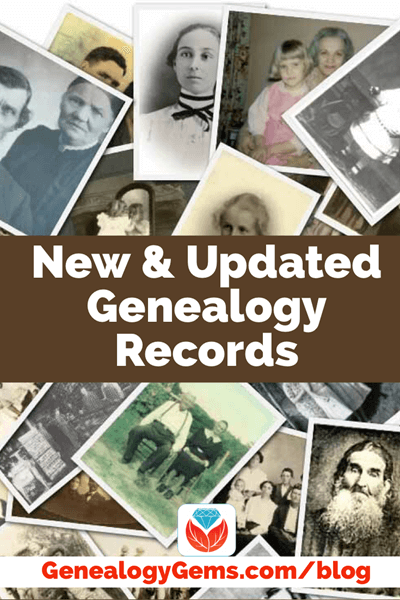
The latest genealogy records from Genealogy Gems.
Ancestry
The first two items in this list of new and updated records is important for everyone who is researching their family history. If you had difficulty finding an ancestor in the 1850 or 1860 in the past, now is the time to search. Ancestry has updated portions of these two important census records.
UPDATED – 1860 United States Federal Census
UPDATED – 1850 United States Federal Census
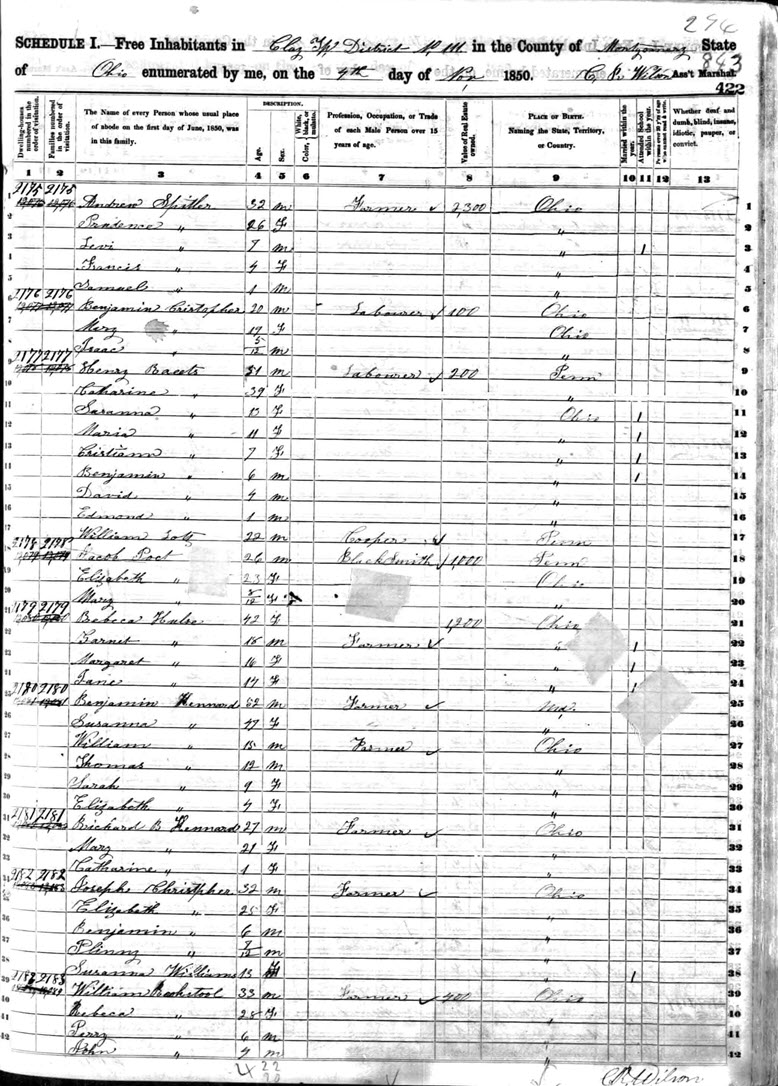
Example of the 1850 US Federal Census.
Speaking of the census, all genealogists are looking forward to the release of the 1950 US census. We don’t have that long to wait now. The 1950 US Census is due to be released to the public in April of 2022. Until then, be sure to read our article answering the most important questions about this census. Read 1950 Census Substitute: What To Use Until its Release Date.
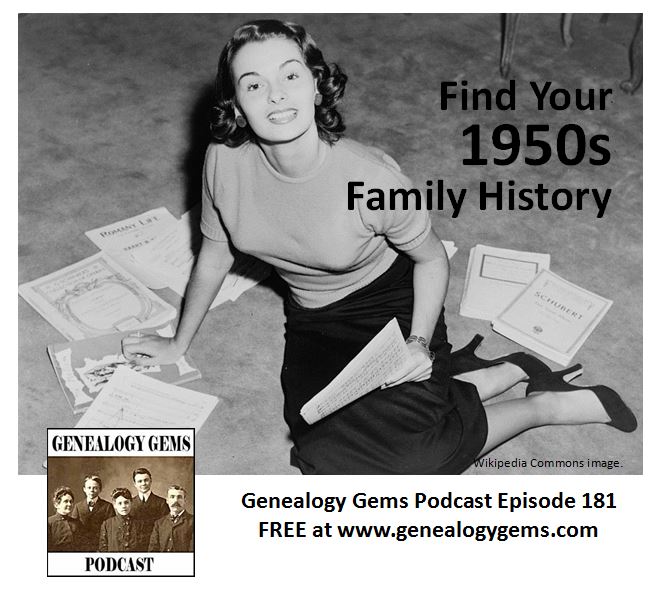
Listen to Genealogy Gems Podcast Episode 181 for more about finding your family history in the 1950s.
Let’s continue on looking through the newest records on Ancestry:
UPDATED – South Carolina, Death Records, 1821-1968
NEW – New York, Episcopal Diocese of Central New York Church Records, 1800-1970
NEW – New York State, Extradition Requisition and Mandate Registers, 1857-1938
NEW – South Carolina Probate Records, Files and Loose Papers, 1732-1964
NEW – South Carolina, Chesterfield County, Original Marriage licenses, 1911-1951
UPDATED Berlin, Germany, Births, 1874-1906
UPDATED – Montana, Divorce Records, 1943-1988
UPDATED – Montana, Birth Records, 1897-1988
UPDATED – Montana, Marriage Records, 1943-1988
UPDATED –U.S., Northern Pacific Railway Company Personnel Files, 1890-1963
One of the important aspects of this update according to Ancestry is that “changes were made to improve the performance of this collection. Family relationships such as parents and spouses are enabled to attach to your tree.
Note: This database does not yet include the entire collection of personnel files. Currently, only the file numbers listed in the browse are included. The remaining files will be added to this database at a later date.”
UPDATED – Ohio, Death Records, 1908-1932, 1938-2018
UPDATED – Ohio, Birth Index, 1908-1998
NEW – Irish Emigrants in North America, 1775-1825
According to Ancestry, “This present work is a consolidated reprint of two pamphlets by Mr. David Dobson that shed light on more than 1,100 Irish men and women and their families who emigrated to North America between roughly 1775 and 1825. As such, this volume adds to the list of 1,000 men and women compiled by Mr. Dobson in three earlier pamphlets in this series, which were published by Clearfield Company as Irish Emigrants in North America. Unlike the earlier collection, which was derived from a variety of Scottish and North American source records, the persons named in Irish Emigrants in North America, Parts Four and Five, were found primarily in contemporary newspapers in Canada and the United States. Each of the two lists of Irish persons is arranged alphabetically by the emigrant’s surname and, in the majority of cases, provides us with most of the following particulars: name, date of birth, name of ship, occupation in Ireland, reason for emigration, sometimes place of origin in Ireland, place of disembarkation in the New World, date of arrival, number of persons in the household, and the source of the information.”
NEW – Web: U.S., Congressional Medal of Honor Society Recipients, 1839 – 2012
UPDATED – Massachusetts, Boston Archdiocese Roman Catholic Sacramental Records, 1789-1900
NEW – Maine, Piscataquis County, Deed Books, 1838-1902
UPDATED – New York, New York, Index to Birth Certificates, 1866-1909
NEW – Maine, Veterans Cemetery Records, 1676-1918
NEW – Maine, Nathan Hale Cemetery Collection, 1780-1980
NEW – Maine, J. Gary Nichols Cemetery Collection, ca. 1780-1999
NEW – Maine, Faylene Hutton Cemetery Collection, 1780-1990
NEW – Maine, Tombstone Inscriptions, Surname Index, 1718-2014
NEW – Maine, York County, Probate Estate Files, 1690-1917
Findmypast
Here are the latest new and updated records from Findmypast, the home of the largest collection of UK parish records online.
Unique to Findmypast, these records can reveal details about the start of your relatives’ lives in Middlesex. The collection has been enhanced with over 17,000 new records from the following parishes:
- Hampton
- Hayes
- Hornsey
- Stanwell
Click here to search.
“Our thanks go to Cliff Webb and West Middlesex Family History Society for providing these latest additions.”
Over 6,000 burials from Mt Pleasant Cemetery, Wisbech, Cambridgeshire have joined the largest collection of British parish records online at Findmypast.

These latest additions join the largest collection of UK parish records online at Findmypast.
Click here to search the Cambridgeshire burial records.
“The burial records date from 1881 to 1925 and have been provided by Fenland Family History Society. You won’t find them anywhere else online.”
Jamaica, Civil Death Registrations
Discover your Caribbean roots with over 1.5 million new civil death registration records from Jamaica. Brought to you in partnership with FamilySearch, these death records can tell you more about your relative’s life and death in Jamaica.
As you trace your Jamaican past, be sure to also delve into these other useful resources:
Dating as far back as the 1500s, our Jamaican family history records are essential for finding out more about your Caribbean ancestors. What’s more, they’ll provide hints for any Jamaican ancestors already on your Findmypast family tree.”
Newspapers
“The Caribbean-themed releases continue in our newspaper collection this week. We’ve added new papers from Jamaica and Ireland and updated a range of others. Brand new to the site are:
While the following newspapers have been supplemented with more issues:
We’ve added almost a century’s worth of pages from one new newspaper along with substantial updates to 10 titles from England and Ireland this week. Brand new to the site is:
As well as that, here is the list of papers that have had more pages added and the years covered:
Newspapers are a goldmine of information on your family’s past. Not only could you find your ancestors making headlines, but you’ll also get insight into the world they lived in, the kind you won’t find in other records.”
MyHeritage
Thanks to the amazing new colorization tool at MyHeritage, their collection of old family history photos is larger than ever before. (Learn more this new tool in our article
Myheritage Launches Colorized Photos!)
As of Mar 26 2020, the updated collection of old photos reached a total of 141,129,707! This is a great time to check your smart matches
Now through April 23, 2020, you can enjoy Free and Unlimited Access to MyHeritage In Color™. Read more about that here.

Click to read the Genealogy Gems article.
by Lisa Cooke | Nov 29, 2019 | 01 What's New, Records & databases |
New records at genealogy websites can come in all shapes and sizes. They may include new or updated indexes, digitized records, or improvements to the search function. It all adds up to new opportunities for you to find more information on your family history. Here’s the latest from some of the most popular genealogy records sites.

New at MyHeritage
Here’s the latest on new records from MyHeritage:
1801 Norway Census Index
“The 1801 census was carried out on Sunday, February 1, 1801, and is based on complete lists of individuals.
The census contains the names of farms (in rural areas), the full names of inhabitants, the familial ties between household members, their age, marital status, and occupation.
For married and previously married people, it was recorded how many times they had been married or widowed.
The age listed was the age on the next birthday.
The names of smallholdings are typically not included. People were registered in the regions where they belonged. Those who were absent, e.g. sailors, should be listed in their hometowns.
The department of statistics of the Exchequer in Copenhagen prepared the census and processed its results. In the rural districts, the census was carried out by parsons with the assistance of precentors and school teachers. In the towns the efforts were supervised by the Town Administration and carried out by the Subdivision Heads of each conscription district. The town lists are arranged by building numbers. This collection is provided through cooperation with the National Archives of Norway.”
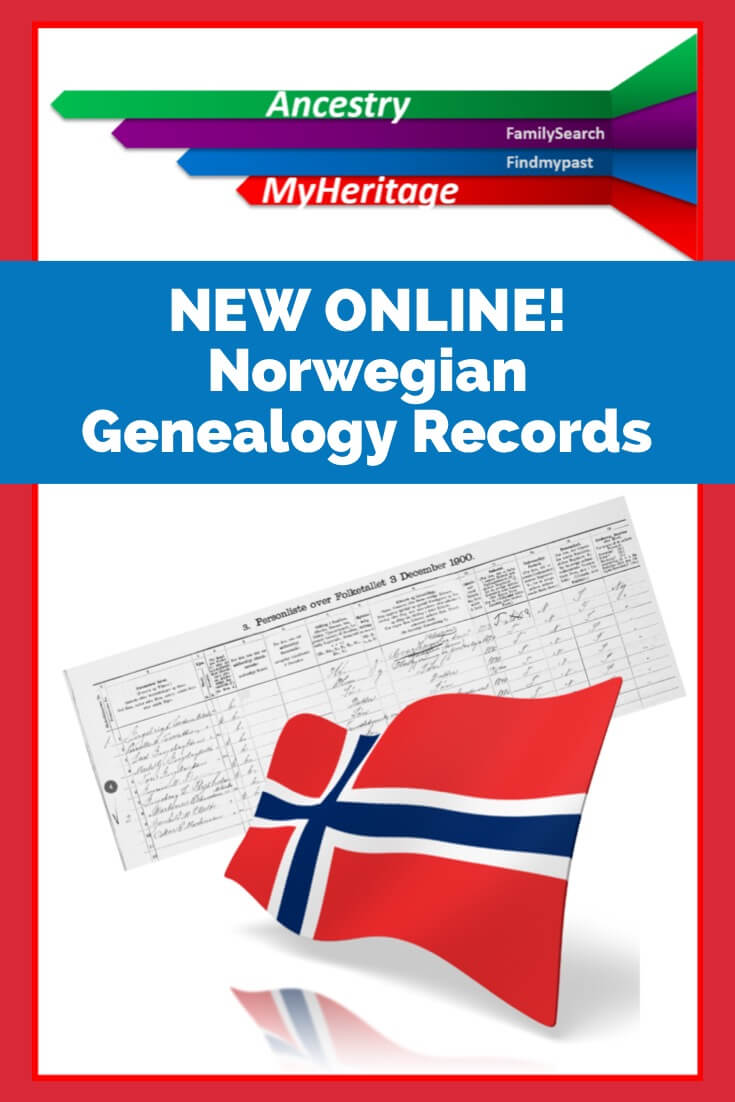
1865 Norway Census Index
“This collection of over 1.68 million records is the first national census to list a place of birth for all persons recorded. This census contains the person’s name, residence, status in the family, occupation, sex, marital status, age, place of birth, religion if not a member of the state church, and other miscellaneous information.
Censuses have been taken by the Norwegian government and by ecclesiastical officials for population studies and taxation purposes.
Census and census-like records are found from the 1500s to 2000. After 1900, a national census was taken every 10 years until 2000. Access to the national census records is restricted for a period of 100 years after the date of enumeration.
Generally, you will find more detailed family information in more recent censuses.
Some known deficiencies in the 1865 original census material include records from Gol parish in Buskerud county, Holtålen Parish in Sør-Trøndelag county, Bjerke parish in the Nannestad dioceses in Akershus county, and at least 106 special lists in Kristiania (Old name for Oslo). This collection is provided through cooperation with the National Archives of Norway.”
United Kingdom, War Memorials, 1914–1949 Index
“This free collection of 1.1 million records provides details on soldiers from the United Kingdom that died during the wars in the early to mid 20th century.
During the first World War, alone, there was an average of over 450 British casualties per day. Information listed on these records may include: name, date of death or burial, burial place, and age at death. These records might also include rank, service and unit of the military as well as any honors earned during service.
The records primarily consist of soldiers from the First and Second World Wars with a few records from different wars. The number of British casualties was smaller in wars following World War II, and the number of records from other conflicts is consequently low.
This collection content is copyright of the Imperial War Museums and the index is provided by MyHeritage free of charge as a beneficial service to the genealogy community.”
Estonia, Gravestones, 1812–2019 Index
“This collection includes information from Estonia cemeteries and consists of records from 1812-2019. These include the name of the deceased, birth date when available, death date when available, date of burial when available, and the name of the cemetery.
Cemeteries can help you trace the burial and or death place of an Estonian relative. Cemetery records may also help identify ancestors when access to church records and census records is limited, or the death was not recorded in other records.”
North Carolina, Mecklenburg County Birth Index, 1913–2019 Index
“This collection is an index of birth records from Mecklenburg County, North Carolina. The records may contain the first name, middle name, last name, gender, and date of birth of the individual. Mecklenburg County is the largest county in North Carolina by population, and its county seat is Charlotte.”
North Carolina, Mecklenburg County Marriage Index, 1884–2019 Index
“This free collection is an index of marriage records from Mecklenburg County, North Carolina. The records may contain the following searchable information: first name, middle name, and last name of the bride and groom, and the marriage date of the couple. Records may also contain the marriage license number and the date of the application.
Mecklenburg County is the largest county in North Carolina by population, and its county seat is Charlotte.
Most records in this collection are from the 20th century or later, with just three percent from before the year 1900. However, there is a select amount of records dated from before 1884, with approximately one percent of the collection falling under this category.”
North Carolina, Mecklenburg County Death Index, 1916–2019 Index
“This free collection is an index of death records from Mecklenburg County, North Carolina. The records may contain the following searchable information: first name, middle name, last name, gender, and death date of the individual. Records may also contain the certificate number for the death. Mecklenburg County is the largest county in North Carolina by population, and its county seat is Charlotte.
In some cases, the gender is given as unknown along with a missing given name. This usually means the record is for a still-born baby. All records in this collection are from the 20th century or later. However, there is a select amount of records dated before 1916, with the earliest from 1908.”
Pennsylvania, Lawrence County Index of Obituaries, 1871–2016 Index
“This collection includes an index of obituaries and death records from Lawrence County Pennsylvania for the years 1871-2016. A record may include the first and last name of the deceased, death date, date of death announcement, name of spouse, name of parent(s), and the name of the newspaper that published the information.
Obituaries can be a good source of information about a person and may also include information about the deceased’s family members. Often an obituary will include information such as the birth date, marriage date, children, occupation, education, and the location of living family members at the time the obituary was written.”
Pennsylvania, Lawrence County Index of Marriage Announcement, 1858–2006 Index
“This collection includes marriage announcements from Lawrence County, Pennsylvania for the years 1858-2006. Records may include the first and last name of the bride and groom, the names of parent(s), the title of the newspaper that published the announcement, the page on which the announcement is located, the date of the marriage announcement, and the year of the marriage.
Marriage records are a valuable source of information. Marriage records found in newspapers are not limited to a specific form, like most government marriage records, therefore newspapers may contain details about a marriage not found elsewhere, such as names of siblings or other relatives.
Newspapers can report marriages of people who no longer live in the area but who still have friends or family there.”
Chile, Electoral Rolls, 2013 Index
“This collection of over 12 million records contains information about Chilean voters during the November 17, 2013 elections. Records include the names of voters and the location of the vote. The collection also includes records about canceled voters, mostly because of the death of the voter, and disqualified voters.
Search these collections at MyHeritage here.
All of the above newly updated collections are now available through MyHeritage SuperSearch™. Searching these records is free, but a Data or Complete subscription is required to view the records, save them to your family tree, and access Record Matches. Our Record Matching technology will get to work and notify you automatically if any of these records mention a member of your family tree. You’ll then have the ability to review the record and decide if you’d like to add the new information to your family tree.”
New Newspaper Content at GenealogyBank
GenealogyBank is one of the leading providers of digitized newspapers, and they’ve recently added new content for 152 newspaper titles from across 35 states including:
- Alabama
- Alaska
- Arizona
- Arkansas
- California
- Delaware
- District of Columbia
- Florida
- Georgia
- Idaho
- Illinois
- Kansas
- Kentucky
- Louisiana
- Maine
- Minnesota
- Mississippi
- Missouri
- Nebraska
- New York
- North Carolina
- North Dakota
- Ohio
- Pennsylvania
- Puerto Rico
- South Carolina
- South Dakota
- Texas
- Virginia
- Washington
- West Virginia
- Wisconsin
Search GenealogyBank here.
Here’s a short video about another historic newspaper resource (click for sound):
More New Newspaper Content at the British Newspaper Archive
One of my favorite websites, the British Newspaper Archive celebrated its 8th birthday this week (the Archive was launched on 29th November 2011) and also reached the milestone of 35 million searchable pages. Here’s ta brief overview of the 128,362 new pages recently added.
New title added:
Updated:
- Elgin Courant, and Morayshire Advertiser (Scotland, 1863-1905)
- The Reading Evening Post
- Wells Journal and the Bristol Times and Mirror (West country area)
Search or start a free trial here.
New at Ancestry
Here’s the latest from Ancestry:
Pre-Confirmation Books
“Pre-Confirmation books, otherwise known as Childrens’ Books, were used to record the names of children who had not yet been confirmed into the Lutheran church. These records are extremely valuable as they record family groups and provide dates of birth and sometimes a place of birth as well. Death dates may also occasionally be included. Once the child became eligible for Communion, they were then recorded in the Communion books.
Pre-Confirmation books were organised by villages and then by farm and household.
This Collection
Users may find the following details for individuals found in the communion books (where available):
- Name
- Gender
- Relation to Head
- Birth Date
- Birth Place
- Burial Date
- Death Date
- Residence”
Search the collection here.
UPDATED: U.S., Social Security Death Index, 1935-2014
On November 14, 2019 changes were made to improve the performance of this collection, so if you’ve ever searched it and not found what you were looking for, it might be worth another try. Note: no new records were added.
Search the collection here.
Washington, Marriage Records, 1854-2013
On May 20 Ancestry added 1,388,625 new records to this collection.
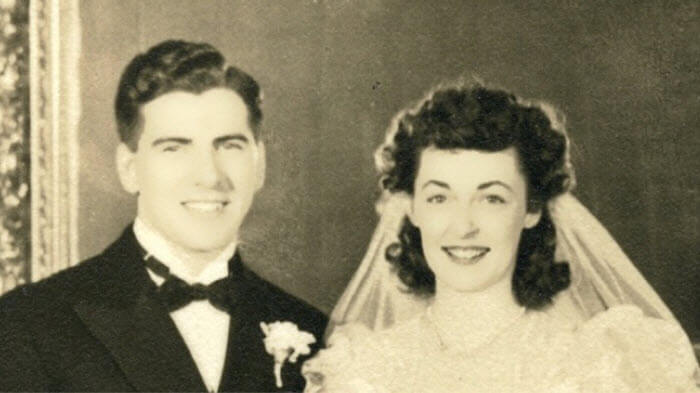
Marriage Records
“This database contains both images of and indexes extracted from various records of marriages in Washington.
Marriage records can offer a wide range of details. While the indexes in this database may provide the basic facts surrounding a wedding—bride, groom, date, and place—images of marriage certificates may also include additional information such as
- addresses
- ages
- race
- birthplaces
- occupations
- marital status (single, divorced)
- whether a first marriage
- fathers’ names and birthplaces
- mothers’ names, maiden names, and birthplaces
This database does not contain an image for every document included in the index.”
Search the newly update collection here.
U.S. WWII Draft Cards Young Men, 1940-1947
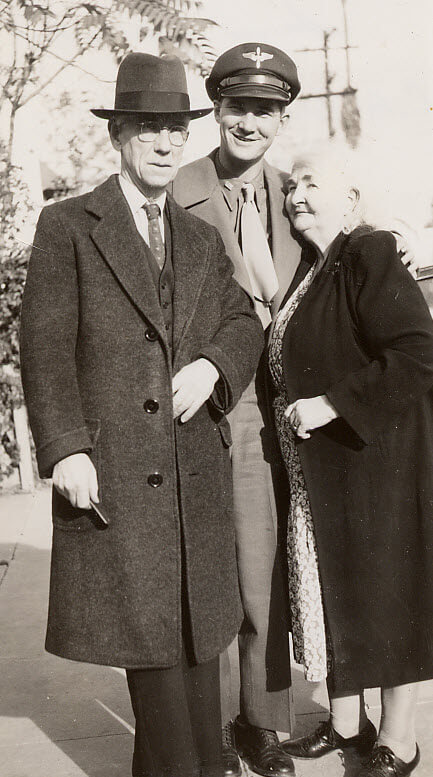
Military Records
On Nov 7 Ancestry added 4,651,830 new records from the following states to the U.S. WWII Draft Cards Young Men, 1940-1947 collection:
- New Jersey
- New York
- North Dakota
- Vermont
- Illinois
- Kentucky
- New Hampshire
Search the updated collection here.
What Did You Find in the New Online Records?
We’ve got our fingers crossed that you are able to unearth some new genealogy gems from these new updates. If you do, please leave a comment and let us know, and then share this post with your friends.
by Lisa Cooke | Mar 12, 2017 | 01 What's New, Irish, Legacy Tree Genealogists |
Let’s trace your Irish ancestors! Irish research tips are a must-have for this historically violent little island. Senior Researcher at Legacy Tree Genealogists, Kate Eakman, shares with you four historical and geographical tips to get you off to the right start.
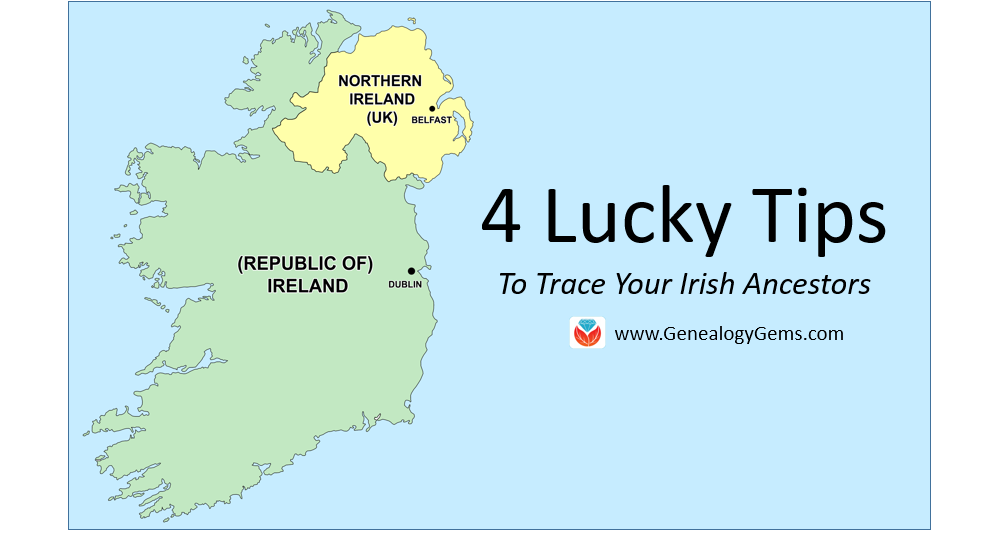
By Jonto at English Wikipedia [GFDL (http://www.gnu.org/copyleft/fdl.html) or CC-BY-SA-3.0 (http://creativecommons.org/licenses/by-sa/3.0/)], via Wikimedia Commons
Trace Your Irish Ancestors: 4 Tips

Kate Eakman from Legacy Family Tree Genealogists
Irish research can be difficult. Although the island is small–about the same size as the state of Indiana–its violent history and many divisions makes research complicated. In addition, many United States records simply report our ancestors were from Ireland with no indication of the county of their birth. However, knowing a little bit about the history and geography can provide the necessary clues. Here are four tips that can help you trace your Irish ancestors from the United States back to Ireland.
Tip 1: Understand the Island of Ireland Today
There are two distinct political entities on the island of Ireland: Northern Ireland and the Republic of Ireland. The dividing line was drawn by England in 1922. This is an important date to keep in mind when searching for more recent Irish ancestors.
The Republic of Ireland, or Eire, is an independent nation made up of the southern 26 counties of Ireland. The Republic of Ireland is predominantly Catholic, with about 3% of the population identifying itself as Protestant. Indices and links to copies of the civil birth records for the years 1864 to 1915, marriages between 1882 and 1940, and death records between 1891 and 1965 are available for free from the IrishGenealogy website. (These records include those of the Northern Irish counties up to 1922.) Official copies can be ordered from the General Records Office in Dublin.
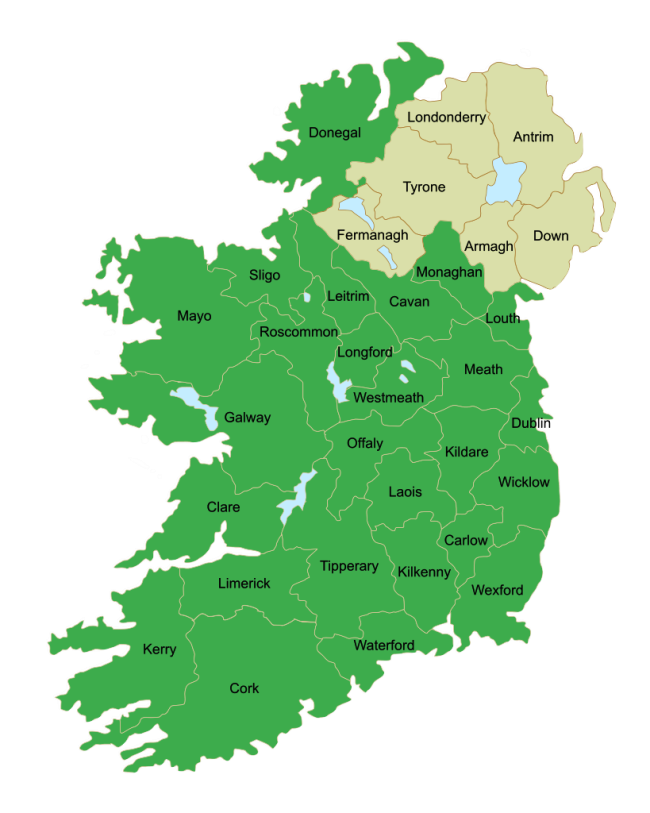
Map of the counties of Northern Ireland and the Republic of Ireland. Photo courtesy https://commons.wikimedia.org.
Northern Ireland, also known as Ulster, is a part of the United Kingdom–although it is self-governing like Canada or Australia. Although the counties of Northern Ireland are not officially used today, it is comprised of the traditional counties of Antrim, Armagh, Down, Fermanagh, Tyrone, and Londonderry (also known by the more traditional name of Derry). Although most Americans believe that Northern Ireland is a Protestant nation, the reality is that today there are almost an equal number of Catholics as there are Protestants in Northern Ireland. Civil birth, marriage, and death records can be ordered from GRONI (General Records Office Northern Ireland).
Tip 2: Turn to U.S. Census Records
From the 1880 U.S. Census through the 1920 U.S. Census, Irish ancestors who immigrated to the United States, or whose parents were natives of Ireland, simply reported they were natives of Ireland. However, since the 1930 U.S. Census was taken after the creation of the Republic of Ireland in 1922, it often noted the specific country from which ancestors originated.
In this sample (below) from the 1930 U.S. census, we can see John O’Reilly was born in “North. Ireland,” as were his mother and her parents. His father, however, was from the Irish Free State, or the Republic of Ireland. This information tells us where to search for John’s birth: in one of the six counties of Northern Ireland. His mother’s birth record will also be from Northern Ireland, and probably his parents’ marriage record also, since it is more traditional to marry in the bride’s hometown than the groom’s.
There is the potential that a much larger search will be necessary for John’s father’s birth record unless the marriage record can be found and it specifies in which of the 26 Republic of Ireland counties he was born.

John J. O’Reilly and his mother in the 1930 U.S. Census report. The detail shows where John was born, then his father’s place of birth, followed by his mother’s place of birth. The second line was the same information for John’s mother. Images courtesy http://ancestry.com.
If your Irish ancestor, or the child of that ancestor, is listed in the 1930 U.S. census, pay close attention to where they reported they and their parents were born. You might find a very helpful clue in that census report.
Tip 3: Look to Religion for Clues
While many people associate Roman Catholicism with Ireland, there are many Protestants living in Northern Ireland and fewer in the Republic of Ireland. Knowing your family’s historical religious preference can provide a small hint. If your family has always been Catholic it is likely they were Catholics in Ireland. However, as we have already noted, with almost all of the Republic of Ireland expressing a preference for Catholicism and about 45% of the citizens of Northern Ireland claiming allegiance to the Catholic faith, you can see a Catholic religious heritage is not particularly unique.
However, if your family history includes the Episcopal faith, or there is something that references “the Church of Ireland” in your family’s records, then your family was most likely Protestant when they lived in Ireland. You are also more likely to find your Protestant ancestors in Northern Ireland (with the understanding that there are Protestants throughout the Republic of Ireland).
If your family is or has been Presbyterian, there is a very strong likelihood your family is actually Scots-Irish with your ancestors immigrating to Ireland from Scotland, bringing their Scottish religion with them. You will find most of these ancestors in Northern Ireland.
Tip 4: Move on to Military Records
World War I (1914-1918) was particularly brutal to the Irish. More than 30,000 of the 200,000 men who enlisted were killed in this war. Songs such as “Gallipoli” and “The Foggy Dew” mourned the loss of so many young Irish men in foreign wars, especially since the 1922 Irish War of Independence followed closely on the heels of World War I.
If one of your Irish ancestors fought and died in World War I, you can find his name and more at the website Ireland’s Memorial Records. Many (but not all) of the memorials include the county in which the soldier was born, as seen below:
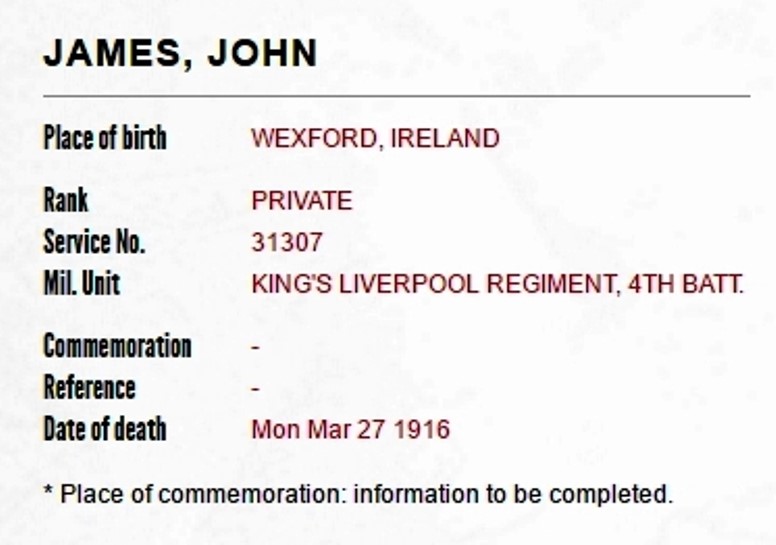
Memorial for John James of County Wexford. Courtesy Ireland’s Memorial Records.
Another website, Ireland’s World War I Veterans 1914-1918, has created a PDF list, updated every three months, which contains over 35,000 names of Irishmen who fought in World War I. If you know or suspect your Irish ancestor may have served in World War I and survived the experience, this is an excellent place to find a clue about his origins.
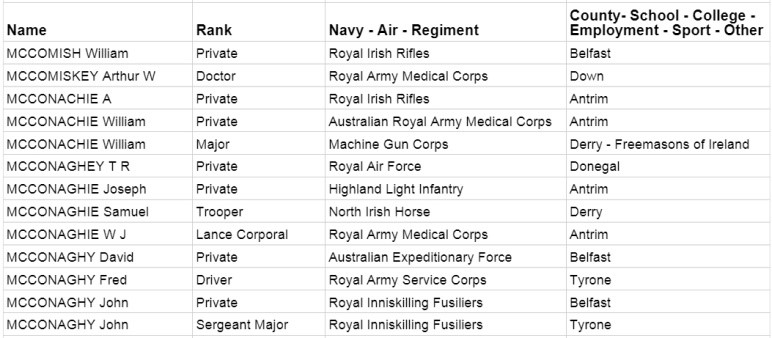
A sample of the list of those who served as created by Ireland’s World War I Veterans 1914-1918.
Although it can be difficult to find the correct place in Ireland for your family’s origins, there are some important clues, both historical and geographical, that can help you pinpoint a place to begin your search in Ireland.
Trace Your Irish Ancestors: In Conclusion
 The 1930 U.S. census can provide an important clue to trace your Irish ancestors, as can your family’s religious heritage. If an Irish ancestor served in World War I, you may be able to determine the county in which he was born. A knowledge of the differences between Northern Ireland and the Republic of Ireland, as well as their location and the counties within those two countries, can help you contact the proper vital records office for those all-important vital records. So, go n-éirí leat! Good luck!
The 1930 U.S. census can provide an important clue to trace your Irish ancestors, as can your family’s religious heritage. If an Irish ancestor served in World War I, you may be able to determine the county in which he was born. A knowledge of the differences between Northern Ireland and the Republic of Ireland, as well as their location and the counties within those two countries, can help you contact the proper vital records office for those all-important vital records. So, go n-éirí leat! Good luck!
The team of expert genealogists at Legacy Tree Genealogists can help bust through your brick walls. They do the research and you enjoy the discoveries!
















